

Grapes. Corks vs Screw Caps. Corks are the classic choice in the question of what goes between you and your wine.
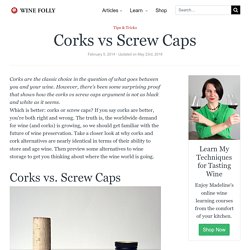
However, there’s been some surprising proof that shows how the corks vs screw caps argument is not as black and white as it seems. Which is better: corks or screw caps? If you say corks are better, you’re both right and wrong. The truth is, the worldwide demand for wine (and corks) is growing, so we should get familiar with the future of wine preservation. Take a closer look at why corks and cork alternatives are nearly identical in terms of their ability to store and age wine. Corks Corks have been the preferred choice for closing wine since the beginning of modern Europe in the 1400’s. Fast forward to today and there are a unique set of pros and cons to natural cork: Cork: Pros.
Terroir. A Chemist Explains Why Corks Matter When Storing Wine. Want to start a wine cellar?

Believe it or not, choosing the right bottle might be just as important as what’s inside. Dr. Andrew Waterhouse, professor of Enology at UC Davis, elegantly explains the importance of bottle stoppers and aging wine. Most foods are best as fresh as possible. I remember picking peaches at my grandfather’s ranch in Northern California and eating them on the spot. Aging and oxygen One aspect of aging has to do with the reaction of fruit acids with the alcohol. Aging Wine: How Can You Tell If a Cabernet Is Worth Cellaring? One of the coolest—and most confounding—things about wine is that it’s alive.
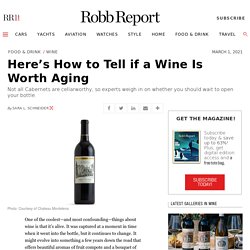
It was captured at a moment in time when it went into the bottle, but it continues to change. It might evolve into something a few years down the road that offers beautiful aromas of fruit compote and a bouquet of dried flowers, complex and intriguing layers of flavor and smooth, integrated tannins that say more about the vineyard and vintage than obvious flavor descriptors. Or it might have gone belly-up and just be limp and tired, with little left to say at all. That’s true even for Cabernet Sauvignon, generally known for its longevity. We asked a couple of winemakers whose bottles famously blossom over time what they’re stuffed with in the first place, how they set up a wine to age and what makes a bottle of Cab at its peak a wonderful thing.
Expert Tips On Choosing Dry White Wines (Video) Explore some expert tips on choosing dry white wines for their texture and complexity.

In this video, Madeline Puckette dives into what makes dry white wines intriguing. Turns out, it’s more than just grape variety that makes up quality. 8 Delicious Alternatives to Syrah (aka Shiraz) We’d all love to try new wines, but how to choose?
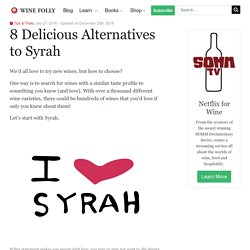
One way is to search for wines with a similar taste profile to something you know (and love). With over a thousand different wine varieties, there could be hundreds of wines that you’d love if only you knew about them! Savvy Sauvignon Blanc Substitutes. Remember the first time the intense aroma of Sauvignon Blanc smacked you in the face?
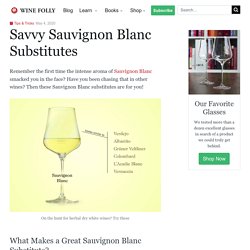
Have you been chasing that in other wines? Then these Sauvignon Blanc substitutes are for you! What Makes a Great Sauvignon Blanc Substitute? When it comes to finding an alternative to Sauvignon Blanc, you have to think about what people love about it in the first place. What’s the Best Wine Glass to Buy: Stemless or Stemmed? Stemless glasses seem to be everywhere — they’re filled with water and wine at restaurants and covered with booze-centric sayings in Etsy shops.

The stemless glass provides a kind of immediacy and ease: You can have your wine, this instant, with less fear of breaking or tipping over a delicate, stemmed glass. According to Tanya Morning Star Darling, a certified wine scholar and teacher at Northwest Wine College, the modern craze for stemless glassware comes from the notion “that anybody should be able to drink good wine in any kind of setting.”
Darling says the idea that wine should be democratic has gained traction over the past few decades, but the stemless glass isn’t exactly new. Chianti Wine: The Taste, Region and Classic Pairings. Chianti wine is as essential to Italian cuisine as extra virgin olive oil.
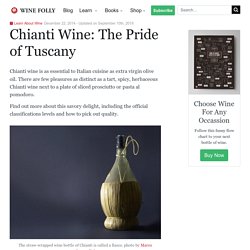
There are few pleasures as distinct as a tart, spicy, herbaceous Chianti wine next to a plate of sliced prosciutto or pasta al pomodoro. Find out more about this savory delight, including the official classifications levels and how to pick out quality. All About Crémant Wine. Crémant is a group of sparkling wines made with the same technique as Champagne, but from outside the Champagne region.
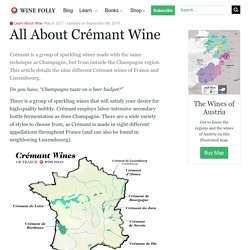
This article details the nine different Crémant wines of France and Luxembourg. Do you have, “Champagne taste on a beer budget?” There is a group of sparkling wines that will satisfy your desire for high quality bubbly. Crémant employs labor-intensive secondary bottle fermentation as does Champagne. There are a wide variety of styles to choose from, as Crémant is made in eight different appellations throughout France (and can also be found in neighboring Luxembourg). 10 Things You Should Know About Sassicaia. When Marchese Mario Incisa della Rocchetta married Marchesa Clarice della Gherardesca in 1930, her dowry included the 7,500-acre Tenuta San Guido estate.
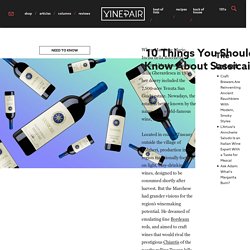
Nowadays, the estate is better known by the name of its world-famous wine, Sassicaia. Located in coastal Tuscany outside the village of Bolgheri, production in the region traditionally focused on light, easy-drinking wines, designed to be consumed shortly after harvest. But the Marchese had grander visions for the region’s winemaking potential. He dreamed of emulating fine Bordeaux reds, and aimed to craft wines that would rival the prestigious Chiantis of the nearby rolling Tuscan hills, and the Barolos of Piedmont in Italy’s northwest. How Finding Wine Flavors Changes Your Brain For The Better. Tips on Finding the Perfect Dry Gewürztraminer. What Color Tells You About a Wine. Dry Red Wines' 'Big Tannins' Are Literally Bigger, Study Says. Why is Wine So Expensive?
Learn to Taste by Taking Better Wine Tasting Notes. Food & Wine. Food & Wine. Maps of Wine Regions & Appellations by Country. What Did Jesus Drink? A Bethlehem Winery is Embracing Ancient, Indigenous Grapes. Linda Gradstein What Did Jesus Drink? A Bethlehem Winery is Embracing Ancient, Indigenous Grapes As millions of people around the world prepare to celebrate Christmas, Bethlehem’s Cremisan Wine Estate has just finished bottling its 2018 vintage. Founded by Salesian monks in 1885, Cremisan makes wine using indigenous Palestinian grapes. Some scholars say these are the types of wines that Jesus most likely drank. “The Salesian fathers started making the first wines, called Messa, to use in churches,” Fadi Batarseh, Cremisan’s winemaker, says.
While winemakers in Israel’s Golan Heights have found success growing imported grapes like Syrah and Cabernet Sauvignon, Cremisan and select others are embracing the fruit that has grown in the region for centuries. The results are smart, sophisticated wines that suit the region’s climate, made with grapes grown nowhere else in the world. The Best Malbec Under $20 - The Reverse Wine Snob® Picks! Why is Amarone Wine So Expensive? We get asked a lot about wines in the sub-$20 range and truthfully, we also drink wine regularly in that price range. However, there are a few times when you want a wine that is worth the money (say, $50-80 a bottle).
Amarone is one of these wines. Understanding Napa Cabernet. Basic Wine Etiquette Tips (Video) As much as I used to hate etiquette as a teenager, I’ve become quite fascinated with it as an adult. There is a lot to learn about etiquette, which can make remembering all the rules seem daunting – particularly because much of it seems quite frivolous on the surface.
After reading two books on the subject, one of them was old (free on kindle!) And one much newer, I started to notice a theme. Etiquette tends to be more involved in places where people operate in high proximity to others. Wine Term: Teinturier Grapes. What is a Teinturier Grape? A teinturier grape is a red wine grape with dark skins and flesh. In contrast, regular red wine grapes have dark skins, but clear flesh. Fittingly, the word “teinturier” comes from the French “to dye or stain.” Teinturier grapes are not a common sight in the vineyard. An Illustrated Guide to Zweigelt From Austria. Everything You Think About Tannins Is Probably Wrong. Everything you think about tannins is probably wrong, but it’s not your fault. Tannins are complicated little bastards, and the wine world has turned them into one of the least-understood aspects of wine drinking.
Technically, tannins are an evolutionary healing and defense mechanism. They break down proteins in plant life, which dissuades grazing herbivores and helps cut or wounded plants heal. An analogy might be the way various clotting agents in our blood help cuts close and scab. But we humans kind of enjoy the way tannins affect our mouths, even if we don’t really understand them. The confusion starts with the fact that we often talk about tannins as having a taste. The real effect they have on the wine drinker, however, is about touch and texture. The Wine Grape Family Vine [INFOGRAPHIC] Guide To Wine Education Courses.
DIY Palate Training Wine Tasting. Try this palate training exercise at home and greatly improve your sense of taste. Understanding Acidity in Wine. Amarone Wine Turns Raisins Into Gold. Amarone wine or as it’s officially named, Amarone della Valpolicella, is one of those wines that you buy and sit on and pray your marriage stays together long enough so that you can drink it on your 20th anniversary. It’s one of those holy-jesus-I-may-now-die-complete wines that, if you’re lucky, you can pick up for around $100. No, Amarone della Valpolicella is not cheap, but it shouldn’t be, it’s just too difficult to make–and too scarce. 12 Fascinating Facts About Red Wine. Archaeologists find earliest evidence of winemaking - HeritageDaily - Heritage & Archaeology News. Excavations in the Republic of Georgia by the Gadachrili Gora Regional Archaeological Project Expedition (GRAPE), a joint undertaking between the University of Toronto (U of T) and the Georgian National Museum, have uncovered evidence of the earliest winemaking anywhere in the world.
The discovery dates the origin of the practice to the Neolithic period around 6000 BC, pushing it back 600-1,000 years from the previously accepted date. The earliest previously known chemical evidence of wine dated to 5400-5000 BC and was from an area in the Zagros Mountains of Iran. Researchers now say the practice began hundreds of years earlier in the South Caucasus region on the border of Eastern Europe and Western Asia. Identifying Flavors in Wine. If wine is made from just grapes, why can some people can taste different fruits such as cherry, pear, or passion fruit? There are also flavor descriptions like butter, vanilla, clove, and even bacon used in many wine tasting notes.
A Guide to Merlot Styles Around the World. Drinkers today have so many opportunities to explore new wines made from obscure grape varieties, the classics can seem unfashionable. But, just like a perfectly tailored navy suit, the classics remain steadfast for a reason. Get To Know The Wines of Bulgaria. An Illustrated Guide to Albariño from Spain. Chianti Lessons – L'OCCASION. An Illustrated Guide to Grenache from France. 5 Merlot Wine Facts. Guide to Petit Verdot Red Wine. Once the Poor Man's Pinot, This South African Red Is Back — in Time for the Weekend. An Illustrated Guide to Sauvignon Blanc From France.
All About Tempranillo Wine in Just About Two Minutes. Viognier ("Vee-own-yay") Wine Guide. What Sommeliers Mean by ‘Traditional’ Versus ‘Modern’ Wines. Guide to 120 Wine Descriptors 18" x 24" Poster - Wine Folly. A Chemist Explains Why Corks Matter When Storing Wine. What Is Greek Wine? Red Wine vs White Wine: The Real Differences. How to Find Surprisingly Affordable Bordeaux. What is Rosé Wine–The Pink Stuff. The Beginner's Guide To Greek Wines. We Need a Better Way to Talk About Red Blends. Find Your Perfect California Red [Flowchart] Here Is Everything Wrong With Drew Barrymore’s Rosé Interview. Stop Hating on Chardonnay and Find a Bottle You'll Love. The 5 Portuguese Wine Styles You Need To Try Based On What You Already Like. Lambrusco Wines Worth Drinking. White Burgundy: The Ultimate French Chardonnay.
Missing Out On Merlot: How Sideways Almost Killed One Of The World's Great Grapes. Understanding Napa Cabernet. Lambrusco Wines Worth Drinking. The Essential Guide to Riesling Wine. Wine Phrases And What They Mean In Plain English. Featured Wine: Nebbiolo. Hacking the wine list: How to see beyond the B.S. and drink like a pro. Taster's Guide to Verdejo Wine. Chilean Cabernet: The Wines, Regions and More. 10 Cool Things to Know About Carménère Wine. Featured Grape: Carménère. How to Order Wine on a Date.
The Secret to Tasting Like A Master Somm: "Impact Compounds" Weird Wine Flavors and the Science Behind Them. A Tale of Two (Very Different) Chardonnays. How To Tell If A Wine Is Age-Worthy. The Only Wine You Need For Your Game Day Party. Central Coast Wine: The Varieties and Regions. The Mourvedre Wine Guide. Rueda - A Guide To Rueda Verdejo White Wine From Spain. 3 Wines that will Change the Way You Think About Wine. 10 Wine Varieties From The Birthplace of Wine. Mastering Mendoza Malbec. What Grapes Make the Best Wine Blends? 9 Wine Terms that Everyone Should Know I WineFolly. DIY Palate Training Wine Tasting. Amazing White Rioja Wines. 11 Obscure Grapes You Need to Know.
3 German Red Wines That Are Meant For Summer. A Primer to Bordeaux Wine. 12 Awesome Things About Cabernet Sauvignon. Virginia Is The Most Exciting Place For American Wine Right Now. Don't Commit This Crime Against Wine! What's Up with Men and Cabernet? Are You Holding Your Wine Glass the Wrong Way? Get to Know Walla Walla Wine. 8 Delicious Alternatives to Syrah (aka Shiraz)